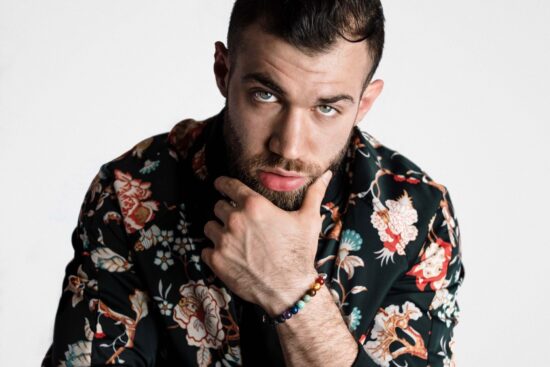
This post may contain affiliate links. If you make a purchase, My Modern Met may earn an affiliate commission. Please read our disclosure for more info.
Texas based storm chaser Mike Mezeul II was the kind of kid that day dreamed about the clouds. Having now photographed storms for over a decade, the fascination has evolved into an awe-inspiring body of work that will leave you with an appreciation for the power and beauty of nature.
Mike’s foray into storm chasing started as a side project from his job in the advertising photography world. Since then, he has turned his childhood passion for weather into a career, and he travels throughout the United States capturing severe weather with his adventurous four-legged best friend, a rescue dog named Joplin.
We were grateful to catch a glimpse into the life of a storm chaser with a Behind The Lens look into Mike’s awe inspiring weather photography. Learn more in our exclusive interview, below.
Storm chaser Mike Mezeul II travels the U.S. photographing severe weather with his rescue dog, Joplin.

Can you tell us a bit about your journey into photography?
I got my first camera, a Yashica MG-1, at the age of 15. I had no interest in photography then, but my dad gave me his camera that he had in the Air Force because he didn’t know how to use it and figured I could learn. I didn’t have a means of transportation back then, so getting around was limited and therefore, so were my subjects. I started my photographing very manly things, like ladybugs and flowers in my parents garden. I had no idea what I was doing, so I took a pad and pen with me and made notes for each frame on lighting conditions, settings, etc. I then saved up my money to get the film developed. From there, it was seemingly endless trial and error. I would look back on my notes and try to understand what I did wrong and how to improve. Over the years, I shot thousands of frames and eventually started getting some of my work noticed as social media came about. I started getting small gigs but then they ended up leading to larger ones, and now I do much of the advertising work in the city I live in. I focused on just shooting advertising, sports, and concert work for a while, but also shot severe weather and landscapes on the side. Eventually, that work became more dominant in my life and a few images went viral. It was then when I started getting requests for workshops and lessons, so I took the jump in 2014 to teaching photography. It has been the best decision ever.
What are some of your interests?
Besides photography? I’m really into hockey and rock climbing. Both are a nice escape from any stresses and I love the challenge. I also like to nerd out quite a bit by just learning random facts about totally random things. Whether that’s just googling on the internet or visiting museums, I love to just learn things most people don’t know.
Where do you call home?
Right now, Allen, Texas. But I really don’t have a place to live that is “mine.” Back in April, I decided to put all my belongings into storage and travel as much as possible. I even built a bed for the back of my Subaru. Luckily, my parents live in Texas and are kind enough to let me crash there when needed.


You’ve photographed severe weather and tornadoes for over a decade, what inspired you to become a storm chaser?
I was always that kid during elementary school who was laying on the picnic table staring up at the clouds rather than playing tag or seeing who could climb on top of the monkey bars the quickest. The sky has always fascinated me and I even remember at one point, being terrified of thunderstorms, but still loving them. When I got my camera, I thought it would be really cool to try and shoot lightning and storms. Even though I didn’t have a car or way to get to them, I would remove all the screens from the second level of my parents house and wait for the next storm to come through. When it did, I would shoot the storms from the open windows. Once I turned 16, it was game over. I had a car and I was out-and-about following and documenting the weather.
A few years ago, you decided to start traveling with your trusty 4-legged companion Joplin, can you tell me a bit more about adopting Joplin and her background story?
Joplin is my storm chasing, partner-in-crime. An old girlfriend and I adopted her spontaneously one day from an SPCA event. We didn’t know it at the time, but Joplin was sick with parvo, so she immediately went into the emergency vet the next day. I had previously lost another dog due to parvo, so I didn’t have high hopes of her pulling through, but sure enough almost two weeks later, she did. During her time in the vet, we named her Joplin, after the city of Joplin, Missouri which was hit by the EF5 tornado back in 2011. My girlfriend and I had both volunteered in Joplin after the tornado and were amazed at how much hope the people there had, that we decided that Joplin was full of hope, so hence the name.



How has traveling with your storm chaser sidekick improved or impacted the experience?
It’s been great, haha. She doesn’t say a word, obviously, but I know she enjoys it. She loves sticking her head out the window and tasting the rain. I don’t think she has ever been scared. It’s also been a ton of fun documenting her with the storms, she’s seen 13 tornadoes.
Can you describe a typical day on the road in the life of a storm chaser?
It’s usually a pretty long day. Typically, the chase starts a day prior to the actual chase day. During that time, you look over forecast models and hope to see trends that indicate where the best atmospheric ingredients will combine 24 hours later. Those models help you get into position for the storms the next day. Typically you have a general idea where you will be, like the Texas panhandle, but it’s still too early to pinpoint an exact location. The morning of the chase, it’s reviewing more data and hitting the road. It’s called storm chasing for a reason, because 99% of the time, you end up in the wrong city to start, so you are constantly monitoring weather trends and repositioning yourself. This is the most stressful part in my opinion. Once the storms fire, the chase is on. It’s great to have just one storm develop, but those days are few and far, so you still have to make sure you choose the right storm based upon the environment it’s in and moving in to. Once you are chasing, it’s all a bit of luck from there on. You need the right storm, the right visibility, the right road network, the right light, and the patience to see something.
What time of the year is best for encountering severe weather? Are there certain conditions you look for?
In the United States, definitely mid-April through early July. This is when the atmosphere is usually primed in the central plains. You have the cool, dry air coming down off the Rocky Mountains, and that air mass usually interacts with the warm, moist air coming northward from the Gulf of Mexico. Now there are a lot more ingredients that need to come together from there, but that’s the general start for a severe weather setup.


Do you have any memories you would like to share of your time searching for storms with Joplin?
One of my favorite memories is when we finally got the shot of her in front of a tornado back on May 24, 2016. It had been two years of trying to get the perfect tornado for her to safely sit and pose in front of, plus I didn’t want her posing with a tornado that did any damage to property or life, so that was needed as well. When it happened, I remember her just chilling in the car and not really in the mood to get out, so I grabbed her and ran her out in the field and put her down and started to try to get her to look at me. I think she gave me one look before wanting to just lay down and sniff the dirt lol. We go the shot though!
From conceptualizing to post processing, how much planning goes into a shoot?
Really, not too much when you are dealing with severe weather. I mean, we all have our “dream shot” but really, you are not in control of what or where you see something out there. With that said, I definitely have visions for shots I’d like to get, but obviously need to be flexible on how to shoot them since mother nature is the one who says, “the tornado goes here.” As far as post goes, what you see is what I saw.
Has experiencing such severe weather impacted how you see the world?
Definitely. I feel like I appreciate what goes on above our heads much more than others. I also take warnings for severe weather and tornadoes much more seriously than most. I feel that’s from the numerous stories I’ve heard from people who survived tornadoes. Most said, “we thought it was another false alarm.”



What challenges have you faced?
As far as photography goes, it’s a very saturated industry, so creating work that separates me from the next person with a camera is challenging, but I like challenges. Also, many people don’t shoot what I do, so it’s nice to have a bit of an upper hand with that.
What’s a must have in your gear bag? How important is gear to your process?
Whether it’s severe weather, landscape, or astro, my Nikon 14-24mm lens MUST be in my bag! The gear is important, but shouldn’t be the reason you do or don’t get a shot. The eye is much more important and the best camera is the one in your hands, regardless of how new or old it is.
How much post processing goes into a completed photo?
Not much, I really like to keep my imagery close to what was seen with the naked eye. I’m not much into manipulating images into something that wasn’t. Typically, a bit of color correction, contrast, and sharpening goes into the image.
Can you share with us a few tricks you may have learned while shooting the weather?
You’re going to get wet, haha. I mean honestly, the weather is unpredictable so you need to be flexible on what and how you shoot. Circular polarizing filters are great when shooting the sky as they can really bring out some nice contrast. Also, a rain cover for your camera is a must. No matter where you try to hide, mist and rain will find you. It’s also important to have an understanding of the weather before even thinking about going out to shooting severe weather. There are so many variables that can come together very quickly to get you in a sticky situation. There are also a lot of hazards to deal with out there, i.e. lightning, large hail, microbursts, flash flooding, etc.


What are your plans for the future? Do you have any upcoming projects?
Right now, I’m really focusing on where to live and preparing for my 2018 workshops. I always take the month of May off to chase, so I’m always looking forward to that. I have some ideas for projects/series though for severe weather, I just can’t give away all my secrets just yet!
Do you have any words of advice for aspiring photographers?
Don’t take no for an answer. If photography is something you want to pursue as a career, it’s a tough road ahead, but not an impossible one. You will have plenty of people tell you that you cannot do it, but that’s the biggest load of bs out there. Find a way to shoot imagery that the industry hasn’t seen much of. Let your creative juices flow and never think that you cannot do something. Also, as I mentioned before, don’t let “not having the best gear” limit you. You can give me a $10,000 oven and I’ll still burn down the house.

Mike Mezeul II: Website | Facebook | Instagram
My Modern Met granted permission to use images by Mike Mezeul II.
Are you a photographer who would like to be interviewed for our Behind the Lens series? Submit through our contact page for consideration!
The post Interview: Storm Chaser Travels the U.S. Capturing Severe Weather with His Fearless Dog appeared first on My Modern Met.







Leave a Reply